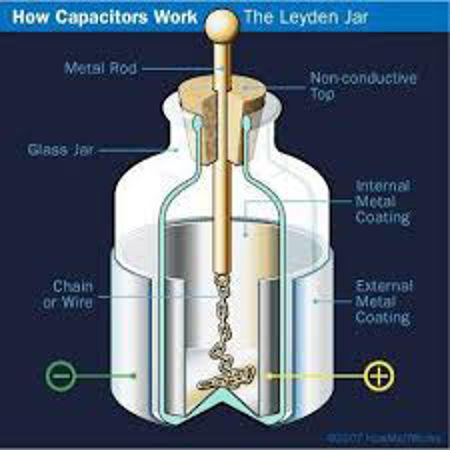The Leyden jar may have a slightly unfair past, since the original discoverer of stored electricity had no hand in its naming. Ewald G. von Kleist made his discovery by accident. While experimenting with electricity, on November 4, 1745, his electric generator came in contact with a nail wedged into a cork and when he touched the nail some time later he received a shock. Sadly, he did not know how or why it happened, and left Pieter van Musschenbroek of Leyden, Holland the opportunity to test and document the process.
A year later Musschenbroek took a jar of water with a metal rod in it and touched it with his electrostatic generator - nothing happened until his assistant touched the rod and was shocked. They discovered that the charge could be stored and the first capacitor was invented.
“Musschenbroek recorded what happened when he first touched the wire after charging the jar: “Suddenly I received in my right hand a shock of such violence that my whole body was shaken as by a lightning stroke. . . . I believed that I was done for.” Musschenbroek proceeded to give detailed instructions on how to build his jar, and in an era of rampant self-experimentation the curious in both Europe and America were quick to give themselves nosebleeds, dizzy spells, and what to some felt like heart attacks during their investigations,” ScienceHistory.org records.
“Van Musschenbroek was lucky in that the news of his discovery spread quickly around Europe, and then around the world. The Leyden jar became very important in electrical research,” as Wikipedia explains.
One of the initial benefits of the Leyden jar was it could be transported easily - much simpler than the electrostatic generators. Benjamin Franklin used one during his kite experiments. Scientists could now charge a Leyden jar and transport the electricity to experiments.
Nearly a hundred years later they became the start of electric lighting, radio and many other world-changing applications. They evolved into what we now call capacitors, once miniaturized. Franklin managed to connect a number of jars and called them a battery (though there is no straight connection to its later use as a term). Actually, Alessandro Volta, while settling an argument with fellow Italian scientist Luigi Galvani in the 1790s, built the first actual battery. This allowed the stored electricity to be used for work over a period of time, as opposed to the all one use of the initial Leyden jars.
And with that. Don’t forget to check out our inventory of capacitors.
contacter:
 FR
FR
 English
English
 Chinese
Chinese
 Italiano
Italiano
 Portuguese
Portuguese
 Deutschland
Deutschland
 French
French
 Russian
Russian
 Japanese
Japanese
 Turkish
Turkish
 Korean
Korean
 Spanish
Spanish
 mon compte et mes commandes
mon compte et mes commandes

